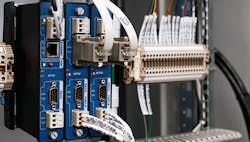Get with the program
Jim Spiller is senior automation engineer at Motion.
What’s the most innovative or efficient machine-controls technology application you’ve ever seen or been involved with?
Jim Spiller, senior automation engineer, Motion: Efficient machine-controls technology is now included in certain brands and models of variable-frequency drives (VFDs) for motor control. These drives offer onboard programmable logic controller (PLC) programming in many different machine languages: ladder logic, structured text function block diagram and others. The benefit to the end user is that VFD programming eliminates the need for an external PLC, saving costs for components, wiring and setup in situations that don’t require a high level of automation.
Also read: 8 tips for PLC design
How has machine-controls technology benefitted from remote monitoring and connectivity?
Jim Spiller, senior automation engineer, Motion: One of the improvements to machine-controls technology has been the advent of mobile and remote human-machine interface (HMI) access to control systems. This is especially advantageous to the end user because machine monitoring and control can be done from a mobile phone or tablet, eliminating the need to walk up to a tethered HMI. The connection can be made through a secure local network. Remote monitoring is also possible off-site with the correct networking hardware and, usually, IT support to ensure a secure connection from the outside world.
When will machine controls become IT-friendly enough that engineers are no longer required for installation and operation?
Jim Spiller, senior automation engineer, Motion: I don’t believe that machine controls will evolve enough in the near future where engineers are no longer required for installing or operating most equipment. Commissioning new or replacement installations can be challenging, especially for the more complex systems. Startups of these systems can involve different trades, such as electricians, engineers and programmers. Equipment startup can include I/O checks, wiring and power confirmation, drive and motor commissioning, programming changes and verifying correct equipment operation. Skilled and experienced people will still be necessary for the safe and successful installation, commissioning and startup of equipment.



